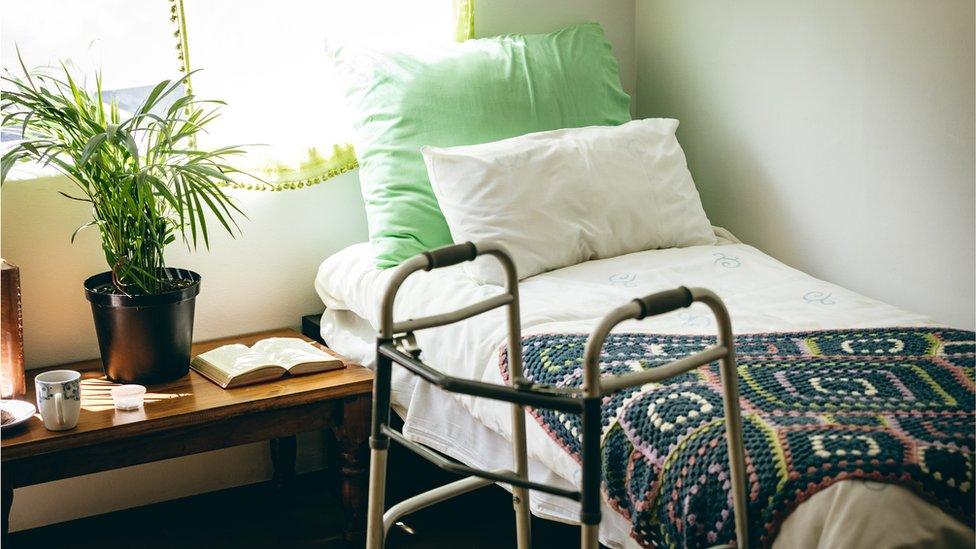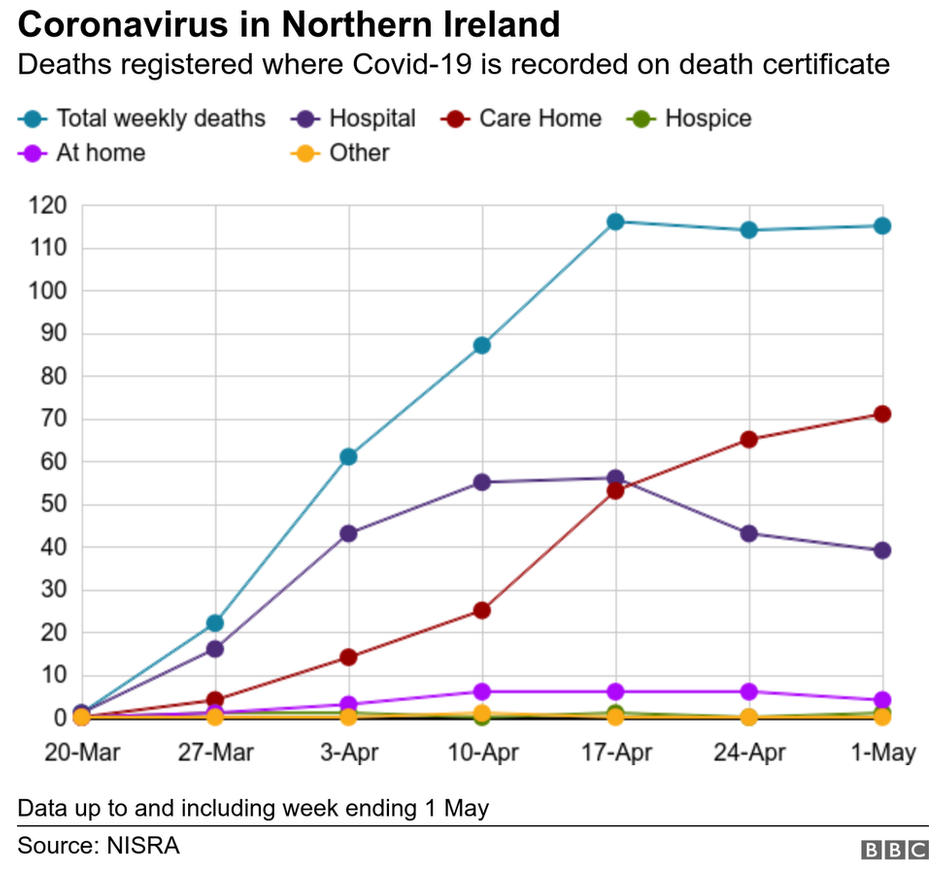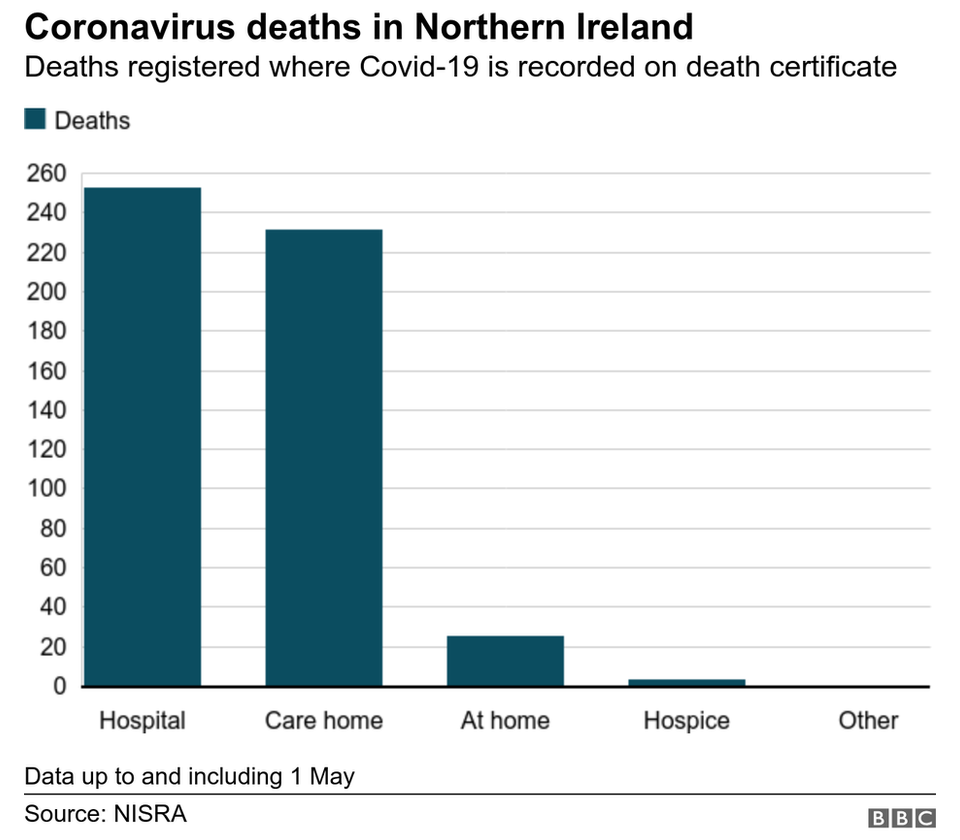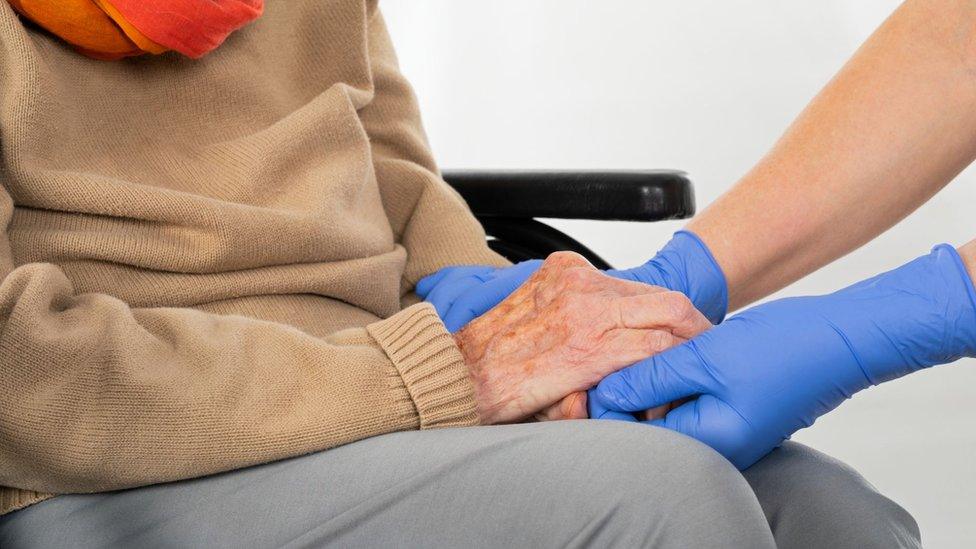Coronavirus in care homes: Michelle O'Neill calls for 'universal testing'
- Published

Nearly half of the 516 deaths Nisra recorded by 1 May happened in care homes
Universal testing for Covid-19 should take place across all of NI's care homes immediately, Deputy First Minister Michelle O'Neill has said.
It comes as official statistics show that for a second week, there have been more deaths in care homes (71) than hospitals (39).
Overall, there have been 232 care home deaths related to coronavirus.
Ms O'Neill said the figures exposed the "serious battle" taking place in care homes.
"There should be a regular programme of testing for all residents and staff and our care homes right now," the Sinn Féin vice-president said on Friday.
"That would help to be able to identify the virus and actually allow speedy action to be taken."
What do we know about the situation in NI's care homes?
Figures released by Northern Ireland's Statistics Agency (Nisra) on Friday show there have been 516 coronavirus-related deaths recorded overall in NI - including 232 in care homes, and four in hospices.

Three separate care homes in Northern Ireland have publicly reported deaths in double figures, including:
Ten deaths at Parkview Care Home in Glencairn, west Belfast, out of 59 residents;
Fourteen deaths at Ringdufferin Nursing Home in Killyleagh, County Down;
Fourteen deaths at Glenabbey Manor in Glengormley.
Currently, residents and staff are only tested for coronavirus in care homes where there is a suspected outbreak, or if they are new entrants to the care home sector.
In the Republic of Ireland, testing of all care home staff and residents is expected to be completed next week.
Why do care homes have such high mortality figures from Covid-19?
Northern Ireland's Chief Medical Officer Dr Michael McBride said there was a degree of inevitability about the prevalence of the virus in care homes.
"It could be anticipated that those older people in our society, those with underlying health conditions would pay a higher price," Dr McBride told BBC Radio 4's Any Questions? programme.
He said as community transmission has decreased across the UK, transmission in care setting, including hospitals and care homes, has "sadly and tragically" increased.
"There was an inevitability to that," he said.
Care homes house people who are particularly vulnerable to coronavirus effects, according to the NI chairman of the British Geriatrics Society.
"It's very challenging for care home staff doing their best to help residents, who may not be able to follow the social distancing advice and might need extra help with care," Dr Mark Roberts told BBC News NI.
For staff trying to deliver compassionate, person-centred care - particularly end-of-life care - the Covid-19 pandemic presents a major challenge, added Dr Roberts.

How can we stop coronavirus spreading in care homes?
Analysis by Louise Cullen, BBC News NI health reporter
Care homes are being described as the "new front line" in the fight against Covid-19, with BBC News NI reporting deaths in double figures at three separate facilities.
Care homes were recognised from the start as being at high-risk from this new, particularly transmissible virus.
That is why many homes moved quickly to suspend visiting, increase cleaning and put personal protective equipment in place, limiting the opportunity for Covid-19 to get a foothold.
Once any kind of virus gets into a care setting like a home, virologists say it can be very difficult to contain.
Read more from Louise here.

The 236 deaths in care homes and hospices involved 66 separate establishments.
Ms O'Neill said the figures demonstrated that Northern Ireland was on a knife-edge.
"Behind all those figures are families who've lost a loved one and we need to realise that, as it drives home the message why we're asking people to continue doing what we're doing for the next three weeks," she said.
The Commissioner for Older People in Northern Ireland said this week Covid-19 testing for everyone living and working in Northern Ireland's 484 care homes should be the top health priority.

More than a fifth of Northern Ireland's care homes - 110 of the 484 - are now caring for vulnerable older people with coronavirus or flu-like symptoms, which are logged each day in care homes' forms about virus activity, the BBC understands.
The homes have a total of 16,000 beds, not all of which are occupied.
The health department said on Thursday it needed to be sure of the quality of the daily information from care homes before releasing more detailed information.
"While good progress has been made, work is still required to validate the data and ensure its consistency," said the department.
"Once work on this data set is complete, we believe it will provide us with more complete information on the position in our homes than any other part of the UK or Ireland."

'More transparency needed'
By Marie-Louise Connolly, BBC News NI health correspondent
Accessing information about the spread of Covid-19 in Northern Ireland's care homes has been very difficult.
The public wants to know what is happening, especially with older and more vulnerable people, but the various health agencies have been providing few verified facts.
Care home owners say they need to manage information about cases and deaths in a controlled, sensitive manner.
While this is understandable, it means the information tends to emerge first from concerned staff or families.
There are arguments about whether the health department should publish data on individual care homes. But there have also been calls for more transparency about the spread of the virus, so that reports on it are as timely and accurate as possible.
Concerned families want - and deserve - to know about their loved ones living and working in these homes; there is no more important time for openness and clarity than during a pandemic.

What is Northern Ireland's overall picture in terms of confirmed cases and deaths?
There is a considerable difference in the death tolls in the two sets of figures published in Northern Ireland.
While Nisra recorded 516 deaths by 1 May, the Department of Health - which records deaths of patients who tested positive for coronavirus, and therefore mostly died in hospital - had recorded 365 deaths by the same date.
Nisra's toll is 35% higher because its weekly bulletin, released each Friday, records all fatalities with Covid-19 mentioned on the death certificate, regardless of where the individual died and whether or not they had been tested for the virus.
So although the health department's daily briefing on Friday recorded 4,022 confirmed cases and five more deaths, taking its toll to 427, the overall death toll will be significantly higher.
The disparity between the two sets of figures has caused confusion, but the department said there was always a time lag for registering deaths in the community - which can take five days - so Nisra's report could not feasibly be linked to the daily figures.
Nisra's report on Friday showed there were 27 patients in intensive care with Covid-19 symptoms, compared to 58 a month ago.
How does Northern Ireland compare to the rest of the UK and the Republic of Ireland?
Although comparisons between countries and regions are difficult due to differences in how statistics are compiled, Northern Ireland's death rate (27 per 100,000 of the population) is similar to that of the Republic of Ireland (29 per 100,000) and significantly lower than that of Great Britain (43 per 100,000).
A further 626 coronavirus deaths were confirmed across the UK on Friday, taking its total to 31,241.
The Republic of Ireland reported 27 more deaths, bringing its total to 1,429.

A SIMPLE GUIDE: How do I protect myself?
AVOIDING CONTACT: The rules on self-isolation and exercise
WHAT WE DON'T KNOW How to understand the death toll
TESTING: Can I get tested for coronavirus?
LOOK-UP TOOL: Check cases in your area

- Published24 April 2020

- Published20 April 2020

- Published15 April 2020

- Published15 April 2020
